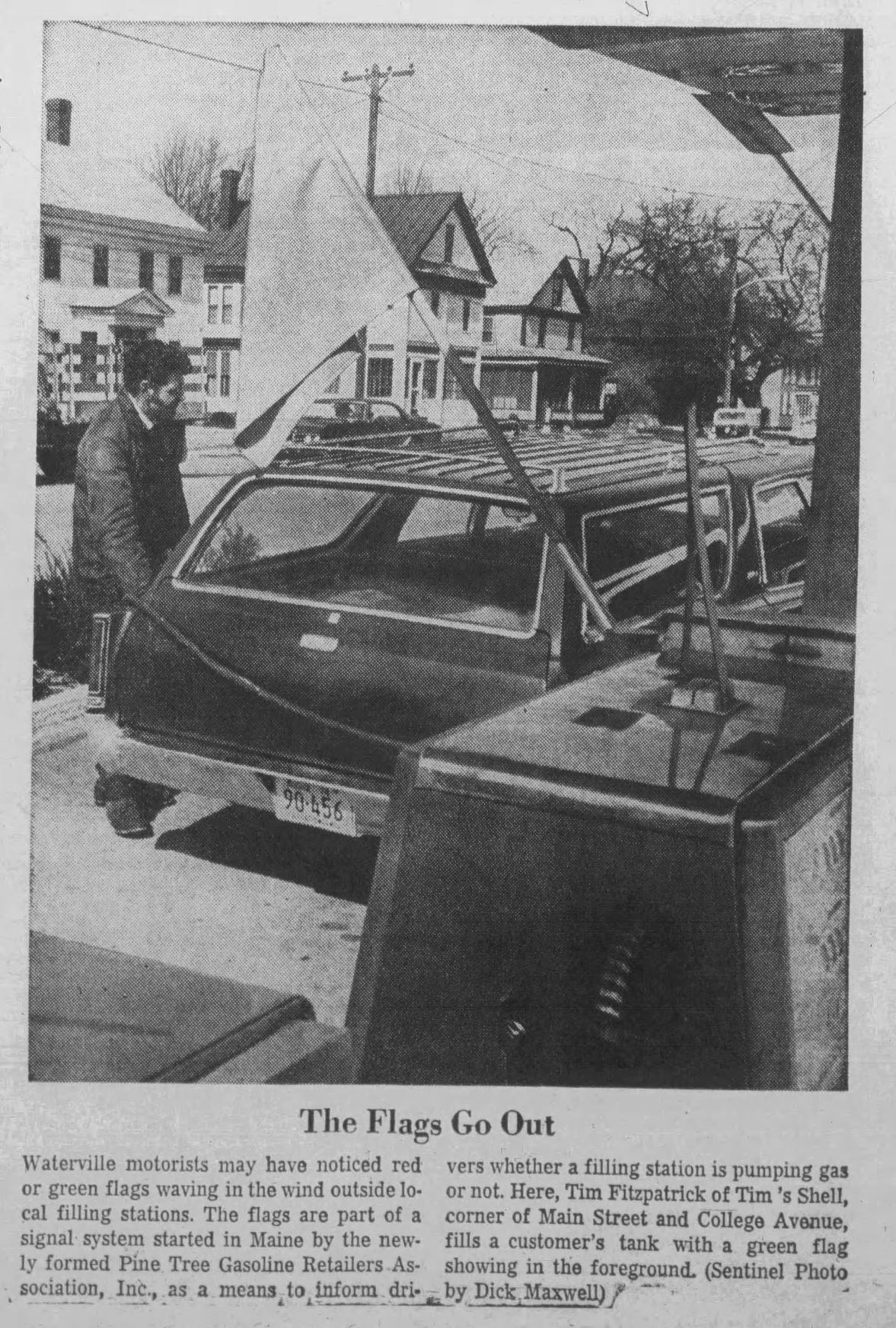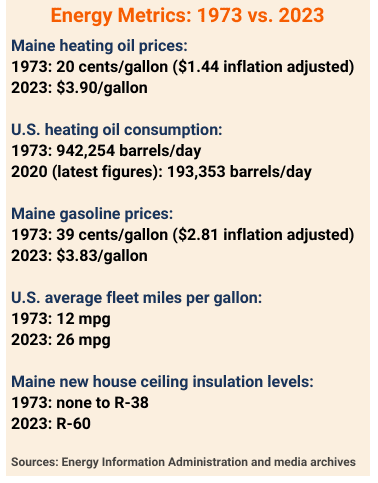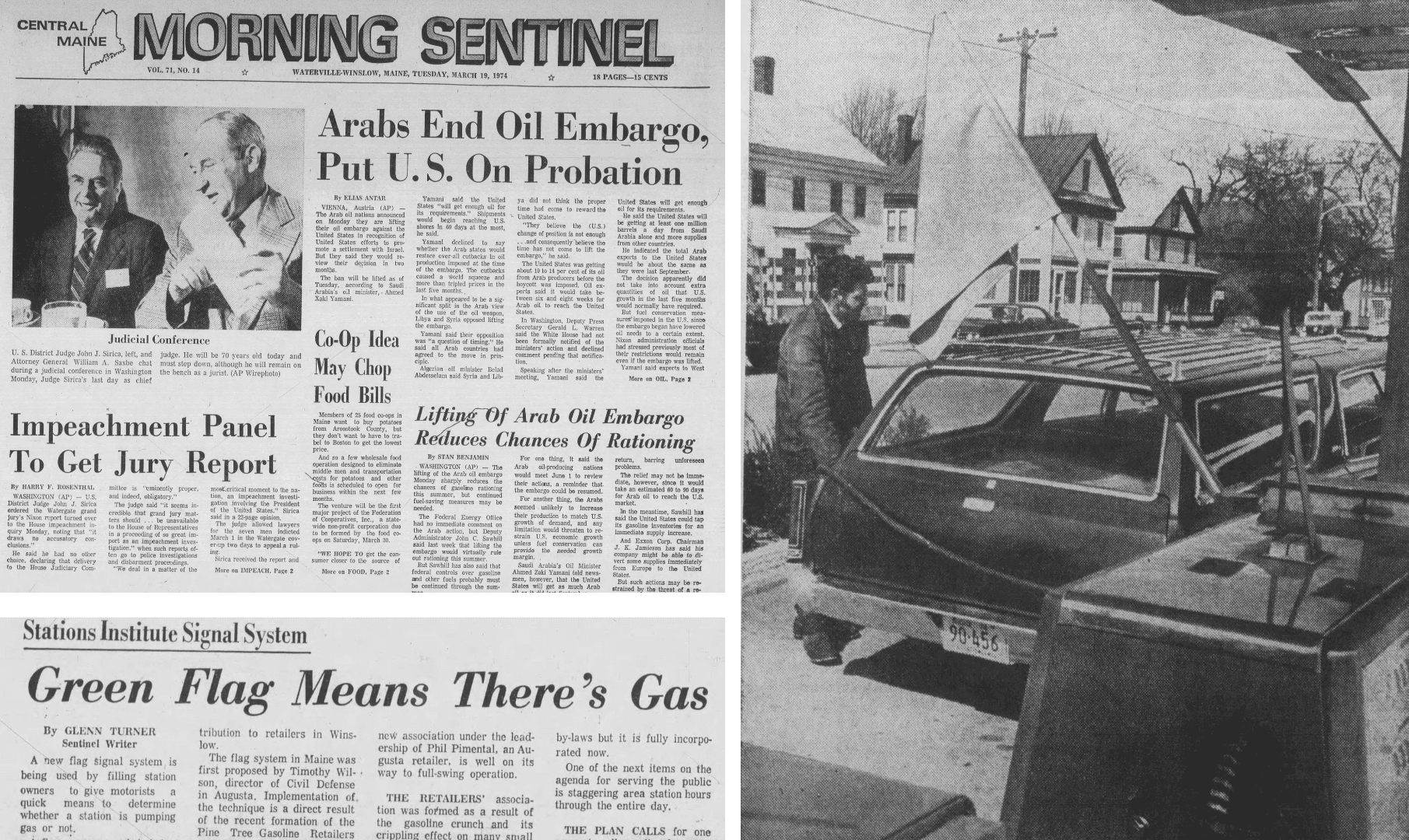It was an audacious plan. Build a major marine terminal in Casco Bay for supertankers to unload crude oil into a pipeline running underground from Portland to a 250,000 gallon-a-day oil refinery in Sanford, 36 miles away. Petroleum products from the $650 million project would then be piped to southern New England.
The idea may sound unbelievable in 2023. But the need for an oil refinery in Maine seemed obvious to many in 1973, and was reinforced 50 years ago in October when the state received a startling wakeup call.
A surprise attack on Israel by Egypt and Syria started the Yom Kippur War. President Richard Nixon’s decision to give Israel emergency financial aid prompted Saudi Arabia and other members of a group few American had heard of — the Organization of Petroleum Exporting Countries, or OPEC — to retaliate by cutting off oil exports to the United States and Europe.
Suddenly, Mainers discovered their way of life threatened by their dependence on energy from unfriendly countries, as the carefree era of cheap petroleum came to a screeching halt. And few parts of the country were as vulnerable as Maine.
In 1973, four in five Maine homes burned heating oil, and experts feared there might not be enough fuel to keep everyone warm that winter. More than 60% of electricity was generated by oil, raising concerns there might not be enough power to keep the lights on. With the average car getting 12 miles per gallon, there might not be enough gasoline to get to work and school.
The first reaction was, we need more oil.
“The idea was, we were in the northeast corner of the United States, a long way from the gulf states,” said Harold Pachios, a Portland lawyer who represented New England Energy Co., the pipeline developer. “The answer was to refine oil in New England, to have a secure supply.”
Pachios, who came home to Maine in 1967 after serving as associate White House press secretary to President Lyndon Johnson, told the company it would never get permits for a refinery on the Maine coast. The company scouted inland York County instead and picked Sanford.
Of course, the refinery was never built. Although it wasn’t apparent during the crisis, October 1973 marked a turning point. It was the beginning of the quest to shift the state’s economy away from fossil fuels and to renewable, domestic energy sources, a pursuit that continues today.
OPEC’s action lasted from Oct. 20, 1972, to March 19, 1973, and became known as the Middle East Oil Embargo. Only six months, but it forever changed the way Mainers think about energy.
Responding to a challenge
The embargo introduced a new term into the American lexicon — energy crisis.
Lacking excess refining capacity, the United States suffered an immediate oil price shock. Crude prices quadrupled, sending retail gasoline from 39 to 53 cents a gallon, according to the federal Energy Information Administration. Heating oil also shot up after selling that autumn in Maine for 20 cents a gallon, or $1.44 in today’s dollars.
But an even bigger shock was supply, or lack of it. Gas stations began running out. Power plant operators and fuel oil dealers scrambled to fill storage.
On Oct. 23, 1973, a full-page ad in the Portland Evening Express posed a question many were asking: “Will there be enough oil to keep us warm this winter?
Maine wasn’t waiting to find out. The state Office of Civil Defense asked each community to ready a shelter large enough to hold four families if they ran out of heat. Gov. Ken Curtis said people might have to stay temporarily in armories or auditoriums.
Expressing a concern that sounds familiar today, Curtis and other New England governors worried that big oil companies were using the crisis to increase profits.
“A nine-cent increase in the heating oil price in Maine will cost the state’s residents $45 million,” Curtis said. “It’s coming out of peoples’ hides and going into the corporate ledgers.”
Businesses and institutions responded. Scott Paper Co. in Winslow prepared to convert one of its oil boilers to coal. The Bass shoe factory in Wilton went to a four-day work week. Thomas College in Waterville turned thermostats down to 65 degrees during the day, 60 at night and 55 degrees over the Christmas break. Maine lawmakers debated whether to wait until warmer weather in March to begin the 1974 legislative session.
The federal government asked 26 oil-fired plants in the United States to consider converting to coal, including Mason Station in Wiscasset. It could be done, Central Maine Power executives said, but the high-sulfur coal available would increase air pollution.
People were desperate for alternatives. In a state that’s more than 90% forest, firewood became a hot commodity. Some dealers were asking $100 for a cord of dry logs, the Associated Press reported, a price equivalent to $690 today. The struggling Portland Stove Foundry suddenly had more orders than it could fill and police reported thieves breaking into seasonal camps to steal wood stoves.
“We burned a lot of wood,” recalled Gordon Weil, who lived in a house with an oil burner, two woodstoves and a fireplace. “We bought four-foot lengths, and my wife and I cut it up in the evenings.”

Weil was a television journalist at the time, commuting between Maine and New York City. He went on to direct Maine’s first state energy office in 1980.
Conserving gasoline became a national obsession.
Congress cut the speed limit nationally to 55 miles per hour and officials considered but ultimately rejected mandatory rationing. But many stations — especially in large metropolitan areas — ran out of fuel.
That created long lines as frustrated motorists sought to fill up before pumps ran dry.
Massachusetts restricted gas sales on Sundays. Some states set alternating days for drivers to fill up — odd or even — based on their license plate number.
Maine set up a system for stations to hang green or red flags, signaling when they were open.
A front-page story in the Portland Evening Express in January 1974 said supplies were better in Maine than Massachusetts, and that while few stations were open Sundays, gasoline was mostly available.
Car dealers, however, saw an immediate drop in sales of the big, eight-cylinder gas guzzlers Americans coveted only a few weeks earlier. Dealers complained they couldn’t get enough four-cylinder Ford Pintos, Chevy Vegas and imported cars that promised 25 miles per gallon.
“The whole trend has gone to small cars,” Sheldon Scott, a Ford and Mercury dealer in Caribou, told the Associated Press.
Planning for more oil
Beyond conversions and conservation, government and industry were focused on increasing Maine’s oil supply.
“The state of our knowledge at the time was to get more, not conservation or efficiency,” Weil said. “How do we get more oil?”
The answer seemed to be to build an oil refinery or two in Maine.
One plan would bring tankers through the swirling tides of New Brunswick’s Head Harbor Passage to a terminal and refinery in Eastport, a proposal from New York-based Pittston Company.
The Sanford refinery proposal was a partnership that included Gibbs Oil Co. of Revere, Mass., and the Burmah Oil Co. of Glasgow, Scotland. Advocates said it would provide 4,000 construction jobs and be one of the largest industrial projects in New England.
At a Department of Environmental Protection hearing, a group called Friends of Intelligent Land Use pushed back on siting a terminal in Luckse Sound off Long Island in Casco Bay, according to the Sanford Tribune.
They had good reason. A year earlier the Norwegian tanker Tomano struck a ledge while approaching Portland Harbor, spilling 100,000 gallons of heavy crude that washed up on Casco Bay beaches.
Still, more oil was seen as part of any solution. Gov. Curtis, a Democrat, suggested the developers work together to build one refinery rather than two.
“I think we’ll build a refinery in Maine and I think we’ll do it in a good, environmental way,” Curtis said.
Meanwhile, New Hampshire officials were entertaining plans to build what was billed as the country’s largest oil refinery, on 700 acres in Durham. Its backer was Olympic Refineries head Aristotle Onassis, the Greek business magnate who married former First Lady Jacqueline Kennedy in 1968.
New Hampshire officials also wanted the feds to endorse drilling for possible oil and gas deposits off the New England coast. And they didn’t want to delay, said Gov. Meldrim Thomson, a Republican, who criticized “little bureaucrats yapping for more time for environmental study.”
None of these ventures came to fruition. The Eastport land is now a state park. But the ideas illustrated how the region’s petroleum addiction drove policy decisions at the height of the crisis.
The situation looked dire in November 1973. An executive with the Northeast Petroleum Institute voiced concerns that tens of thousands of jobs might be lost, schools might close and Christmas lights could be banned. Symbolic of the panic mentality, the giant illuminated Citgo sign in Kenmore Square near Fenway Park in Boston was turned off.
The state’s largest oil importer, C.H. Sprague, predicted that some Maine homes would run out of heat in the upcoming winter.
“There’s not enough oil to go around,” Harry Powers, the company’s president, told the Portland Press Herald. “Someone’s going to go cold.”
As it turned out, the combination of a milder-than-normal winter and conservation measures helped keep Maine from running out of heating oil.
By spring the crisis began to ebb. This was the humbling headline in the March 19, 1974, edition of the Central Maine Morning Sentinel: “Arabs End Oil Embargo, Put U.S. On Probation.”
‘Electricity is the solution now’
Fifty years later, oil’s stranglehold on Maine is loosening but has not let go. Maine has a climate action plan with an initial goal of cutting greenhouse gas emissions by 45% by 2030, but that aspiration faces challenges.

Better insulated buildings use less fuel, but 6 in 10 homes still burn oil, the largest share in the country. And residents remain vulnerable to global shakeups.
Only last year, heating oil spiked at more than $5 a gallon after Russia invaded Ukraine. As the 2023-24 heating season begins, the average price in Maine is $3.90, according to the Governor’s Energy Office mid-September survey.
Automobiles get much better gas mileage, but the overall fleet average for cars and light trucks is just 26 miles per gallon. And despite the buzz about electric vehicles, Maine has only 5,000 or so all-electric cars on the road today.
More progress has been made in electricity supply. Hydroelectricity and wind each provide roughly one-quarter of instate generation, although natural gas is the chief generating fuel in New England.
Today’s big environmental battles aren’t about oil refineries and pipelines, but renewable energy projects and the transmission lines to carry their power.
“Electricity is the solution now,” Pachios said, noting the trend to high-efficiency heat pumps. “In the old days people said, ‘don’t heat with electricity, it’s so expensive.’ What we tried to get away from is the solution now.”
Weil is less optimistic, a half-century later.
“The difference now,” he said, “is we know what the problem is but we’re still very dependent on hydrocarbons. We just don’t have sufficient willingness to do what’s necessary.”






